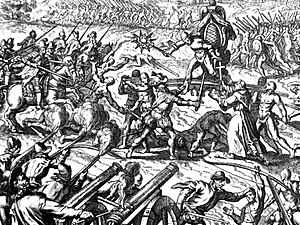Battle of Cajamarca
| Battle of Cajamarca | |||||||
|---|---|---|---|---|---|---|---|
| Part of the Spanish conquest of Peru | |||||||
 Contemporary engraving of the Battle of Cajamarca, showing Emperor Atahualpa surrounded on his palanquin. |
|||||||
|
|||||||
| Belligerents | |||||||
|
|
|
||||||
| Commanders and leaders | |||||||
|
|
Atahualpa (POW) | ||||||
| Strength | |||||||
| 106 infantry 62 cavalry four cannons 12 harquebuses |
3,000–8,000 unarmed personal attendants/lightly armed guards | ||||||
| Casualties and losses | |||||||
| 0–5 dead; one wounded |
2,000 dead 5,000 taken prisoner |
||||||
The 'Battle' of Cajamarca was the unexpected ambush and seizure of the Inca ruler Atahualpa by a small Spanish force led by Francisco Pizarro, on November 16, 1532. The Spanish killed thousands of Atahualpa's counsellors, commanders and unarmed attendants in the great plaza of Cajamarca, and caused his armed host outside the town to flee. The capture of Atahualpa marked the opening stage of the conquest of the pre-Columbian Inca civilization of Peru.
The confrontation at Cajamarca was the culmination of a months-long struggle involving espionage, subterfuge, and diplomacy between Pizarro and the Inca via their respective envoys. Atahualpa had received the invaders from a position of immense strength. Encamped along the heights of Cajamarca with a large force of battle-tested troops fresh from their victories in the civil war against his half-brother Huáscar, the Inca felt they had little to fear from Pizarro's tiny army, however exotic its dress and weaponry. In a calculated show of goodwill, Atahualpa had lured the adventurers deep into the heart of his mountain empire where any potential threat could be isolated and responded to with massive force. Pizarro and his men arrived on Friday November 15, 1532. The town itself had been largely emptied of its two thousand inhabitants, upon the approach of the Spanish force of 180 men, guided by an Inca noble sent by Atahualpa as an envoy. Atahualpa himself was encamped outside Cajamarca, preparing for his march on Cuzco, where his commanders had just captured Huáscar and defeated his army.
The book History Of The Conquest Of Peru, written by 19th century author William H. Prescott, recounts the dilemma in which the Spanish force found itself. Any assault on the Inca armies overlooking the valley would have been suicidal. Retreat was equally out of the question, because any show of weakness might have undermined their air of invincibility, and would invite pursuit and closure of the mountain passes. Once the great stone fortresses dotting their route of escape were garrisoned, argued Pizarro, they would prove impregnable. But to do nothing, he added, was no better since prolonged contact with the natives would erode the fears of Spanish supernaturality that kept them at bay.
...
Wikipedia
